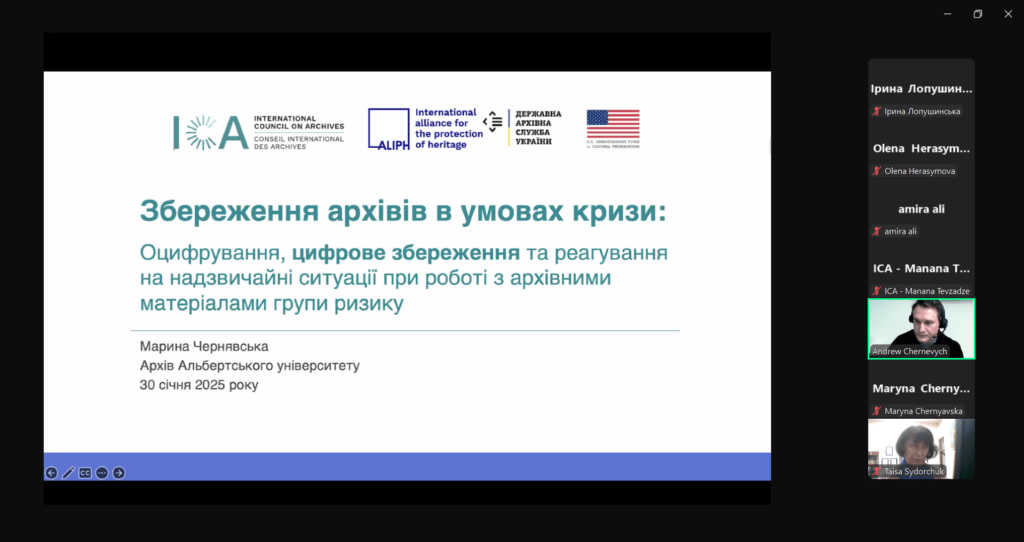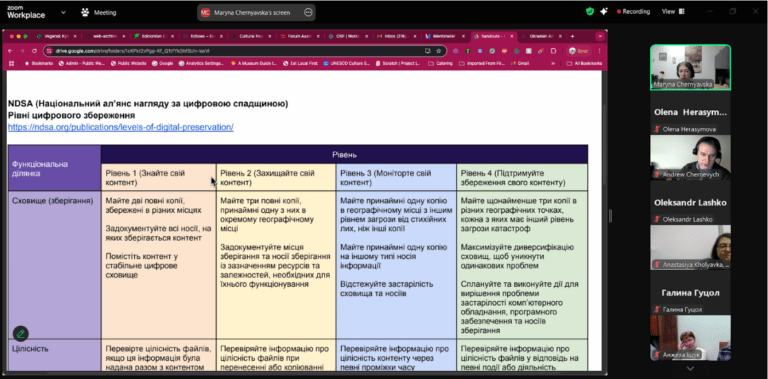Digitization and Digital Preservation of Archives: Results of the ICA Training Program
This report summarizes the results of the training program on digitization and digital preservation of archives. In February 2025, the staff of the M. Maksymovych Scientific Library participated in a training program organized by the International Council on Archives (ICA). The program consisted of eight online seminar sessions that addressed the topic of “Preserving Archives in Times of Crisis.” The sessions covered key aspects such as digitization, digital preservation, and emergency response practices for archival materials.
Document Scanning and Prioritization
The training program encompassed the entire cycle of digitizing archival documents, beginning with the critical step of prioritization: which documents should be digitized first?
The process of prioritization involves assessing documents based on four primary values: monetary, cultural, utilitarian, and legislative. Furthermore, a specialized tool can be used to rank these values according to additional criteria, including:
- Uniqueness
- State of preservation of the object
- Suitability for digitization
- Total volume of the document
- Permanence (longevity) of the medium
Andriy Chernevych, responsible for the regional archive in Lethbridge, Canada, presented a comprehensive overview of the process of preparing documents for scanning and outlined the key characteristics of scanners. During one of the workshops, participants had the opportunity to observe the scanning process in action.
The seminars provided guidance on selecting planar or flatbed scanners based on various document parameters.
Several auxiliary guides for the scanning process were recommended:
- Guidelines for Handling, Preparing and Digitizing Archival Paper and Printed Materials, National Archives of Australia, 2019. https://www.naa.gov.au/sites/default/files/2019-08/Guidelines-for-handling-preparing-printed-materials.pdf
- Digitization Guidelines, Libraries and Archives Canada, 2024. https://library-archives.canada.ca/eng/services/government-canada/information-disposition/disposition-government-records/multi-institution-disposition-authorizations/Pages/digitization-guidelines.aspx
Electronic Document Management
The digitization of documents results in a significant increase in the amount of information that needs to be stored. Therefore, during the workshops led by Maryna Cherniavska, a digital archivist at the University of Alberta Archives, participants discussed issues related to file organization and the management of digital objects. Particular emphasis was placed on the importance of documenting every step of the process, as the composition of material resources and team members may change over time.
An effective tool for the digitization of collections is the NDSA (National Digital Stewardship Alliance) Levels of Digital Preservation. This framework enables the identification of specific technological stages—ranging from basic to advanced—in the digitization process of a particular archive. By regularly assessing an archive’s level, it becomes easier to plan subsequent development steps.
Maryna Cherniavska provided a clear explanation of the essence of the Open Archival Information System (OAIS) model. This model is widely accepted and applies not only to archival affairs but also to fields such as education and business. It offers the industry universally comprehensible terminology and facilitates informed decision-making.
During the workshops, participants also explored the Archivematica digital preservation system. While it does not serve as a repository for digitized materials, it functions as a filter protocol for interacting with the repository. Archivematica structures data and mediates the preservation process effectively.
It is important to note that digital preservation is not synonymous with digitization. Digitization is merely one component of the broader digital preservation process.
When creating electronic documents through scanning, care must be taken to preserve the original document itself, as this is also an essential aspect of digital preservation. The preservation of archives during times of crisis, including wars, was addressed in a separate training block. Ms. Amira Ali shared tools and methodologies for crisis management in archives.
Crisis Management
The Ukrainian archival community has been actively sharing its expertise with both foreign and Ukrainian colleagues on crisis management. Iryna Lopushynska, Director of the Kherson oblast Archives, used the example of the destruction of the Kakhovka hydroelectric power plant to outline an algorithm for emergency preparedness and identify the key participants in the evacuation process. However, the extensive experience accumulated by the Ukrainian side underscores the necessity of thoroughly documenting all procedures.
Digitization and digital preservation of documents are not merely technical processes; they are also vital cultural and historical undertakings for libraries and archives. Compliance with modern standards, the use of appropriate equipment, and effective organization of processes contribute to preserving unique materials for future generations.
The workshops were organized by the International Council on Archives (ICA) in collaboration with the State Archival Service of Ukraine. They were funded by the International Alliance for the Protection of Heritage (ALIPH) with financial support from the U.S. Ambassadors for Cultural Heritage.






